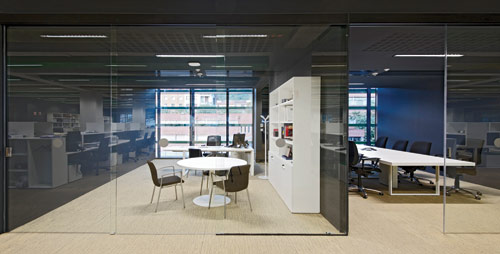Interior Sliding Frameless Glass Doors Make a Clear Contribution to LEED
Influenced by the desire for teamwork, the miniaturization of technology, and mobility of the workforce among other factors, today's office is more personalized, with customizable work scenarios in sleek, smart, and streamlined environments in which, trend watchers agree, natural light is essential. Customizable is key, with the ability to easily move or reconfigure workstations and conference areas to mesh with changing team sizes, corporate strategies, or work styles. Still, as every employee knows, there must be a balance between the public areas and the private workspace. Glass is a natural delineator of private space in an open office: glass partitions, movable glass walls, and sliding glass doors all allow natural to enter the space, while masking sound, and creating a separate space for concentration that workers need.
In today's economy, companies are subject to constant rounds of up-sizing, down-sizing and otherwise right-sizing, and consequently favoring modular office systems that can be easily dismantled and stored, re deployed, or added to. Many younger entrepreneurs with growing companies want flexibility, and the ability to expand their businesses easily using an existing template, even going as far as taking their investments with them to larger quarters. With a growing concern for true sustainability and end-of-life issues, owners are increasingly interested in interior materials that will not be relegated to landfills, prematurely or otherwise. With ultimate modularity and full recyclability, easily demountable glass doors and partitions fit this changing mindset.
| IDOM Group Headquarters—A Light, Bright Space Achieves Space Planning Goals | ||
One of the most important design goals was to achieve a wide and an open-plan working space that would promote intra- and inter-departmental visual communication without barriers between the different levels of duties and appointments within the IDOM company. The widest working spaces accommodate meeting rooms or team working areas, rather than individual offices. In order to avoid psychological barriers between the offices, the rooms and the open space, IDOM opted against a traditional front office glass door including a fixed glass and a swing door for glass sliding doors to remove those psychological barriers. The company chose a telescopic and synchronized system to integrate the different spaces and to reach the set goal. The doors specified have a wider opening than others on the market and provide a clear passageway without any floor hardware or mechanism. In order to maintain the integrated concept and accommodate building needs in some offices, either recessed tracks or exposed tracks were used with a special black anodized aluminum finish that matches the dark ceiling. |










